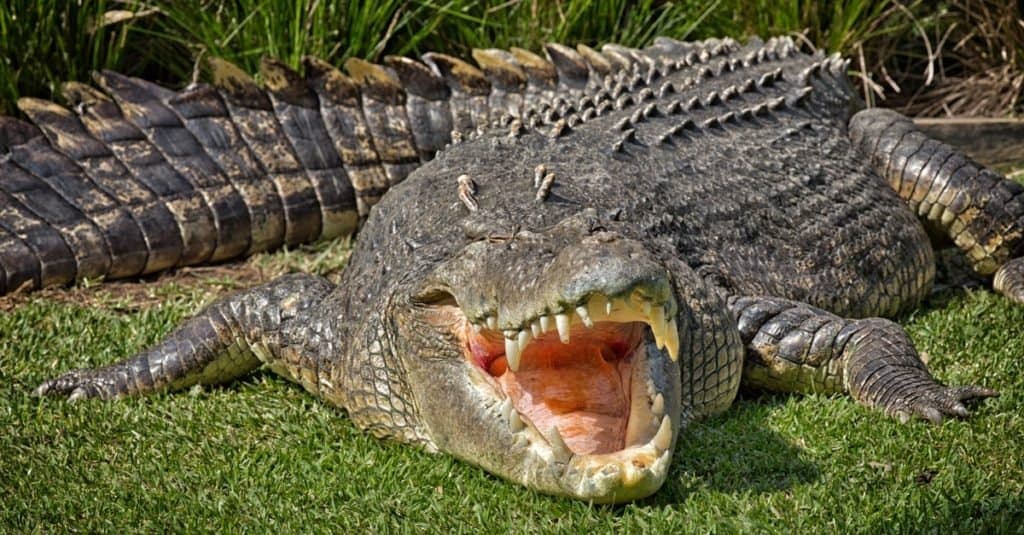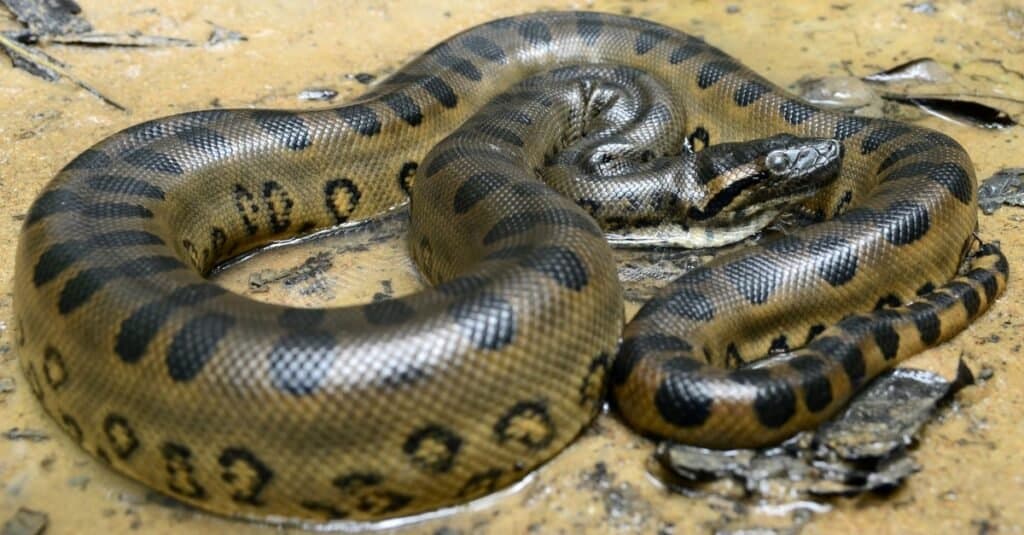Saltwater crocodiles and anacondas are two creatures that strike fear in the hearts of humans. Both of them attack from the murky depths of water or in the vegetation surrounding it. Their attacks on other creatures are quick, brutal, and overwhelming. That makes them the perfect candidates for an epic battle. With that in mind, we’re going to take the available data concerning a saltwater crocodile vs anaconda fight and determine which one of them has the best chance to win a fight against the other!
Given that they don’t share a range, we’ll also have to use our imaginations to set the stage for this battle!
Comparing Saltwater Crocodile vs. Anaconda
| Saltwater Crocodile | Anaconda | |
|---|---|---|
| Size | Weight: 400-1,150 pounds, but higher weighs are possible Height: measures between 10 and 21 feet long, but lengths up to 23 feet have been recorded | Weight: 250-550 pounds Length: 17-22 feet Diameter: reach 12 inches in some cases |
| Speed | – Swims at 15-18 mph at top speed, averaging less – Can move on land between 12 and 22 mph for very short distances | – Roughly 3-5 mph on land, but only for short distances – 10 mph swimming speed |
| Defenses | – Their thick, scaly skin makes them hard to bite – Large body makes few creatures want to risk an attack – Blend into murky water and nearby vegetation and mud – Ability to move on land and in water makes them hard to catch | – Their eyes are situated near the top of their head, allowing them to swim and keep a lookout for danger or prey – Their skin colors often help them blend into their surroundings while swimming or on land – Large size would make many creatures avoid them |
| Offensive Capabilities | – Has one of the most powerful bites in the animal kingdom at 3,700 PSI – Their 66 teeth are meant for biting and holding prey while tearing it apart – They use a death roll to dismember and disorient their prey – Often drag prey into the water where they have more of an advantage | – Have 100 rear-facing teeth to bite its prey and help them wrap around its body – Can exert 90 PSI squeezing power when wrapped around prey – Have great hunting senses – Can detect heat, vibrations, and chemicals from other animals |
| Predatory Behavior | – Ambush predators that typically attack by using the cover of water – They will drown or cause significant physical harm to their prey before consuming it | – Ambush predators that attack prey both in water and out of water – Constricts their prey and then consumes it whole |
The 2 Key Differences Between Saltwater Crocodiles and Anacondas

Saltwater crocodiles are the largest crocodile species and also the largest living reptile in the world.
©PomInOz/Shutterstock.com
The greatest differences between a saltwater crocodile and an anaconda regarding a fight are their size and methods of attack. Anacondas weigh anywhere from 250 to 550 pounds, grow between 17 and 22 feet long, and have a diameter of 12 inches at their largest.
Meanwhile, a saltwater crocodile can weigh anywhere between 400 and 1,150 pounds on average, but they can weigh over 2,000 pounds at their largest. They grow between 10 and 21 feet long, but even longer crocs have been recorded, up to 23 feet!
Saltwater crocodiles bite down hard on their prey and then tear it apart, often using a death roll. Anacondas will bite their prey, but usually only to provide a contact point to start wrapping around their prey. They then exert a tremendous amount of force to cause the circulatory system to fail in their prey.
The sizes and methods of attack used by these two creatures will have a significant impact on the way that this fight unfolds. Yet, we need to explore other facets of this fight to say which one wins.
What Are the Key Factors in a Fight Between a Saltwater Crocodile and an Anaconda?
When considering this fight, we need to account for a variety of information. Specifically, we’re going to look at which creature is larger, which one is faster, how their defenses work, and how they attack and kill their prey. All these factors need to be examined so that we can say which reptile has the better chance of surviving this fight.
Let’s look at five major factors for this fight and see which animal has the advantage in each. When we’re finished, we’ll put it all together with a bit of guesswork to see who wins the battle!
Saltwater Crocodile vs. Anaconda: Size
The average saltwater crocodile is heavier than the average anaconda, but they’re also shorter in many cases. The average saltwater crocodile can reach weights of 1,150 pounds, far greater than the anaconda’s 550 maximum weight.
Yet, the anaconda measures between 17 and 22 feet long, greater than the maximum average length of 21 feet for the saltwater crocodile, but shorter than the largest saltwater crocodile ever recorded.
The overall mass and size of the saltwater crocodile are greater than the anaconda, so it gets the advantage.
Saltwater Crocodile vs. Anaconda: Speed and Movement
Anacondas are faster than they look in the water, but they’re slower than saltwater crocodiles. An anaconda’s maximum short-distance speed in the water is about 10 mph, but the saltwater crocodile can reach up to 12 to 18 mph.
On land, the anaconda can move at about 5 mph, but the saltwater crocodile can hit speeds of up to 22 mph, but only for very, very short distances reserved for attacking prey while coming out of the water. Otherwise, it has a slow movement speed on land of between 5 and 7 mph.
At their maximum speed, saltwater crocodiles are faster than anacondas for short bursts, but that’s all they’ll need for this fight.
Saltwater Crocodile vs. Anaconda: Defenses
Both anacondas and saltwater crocodiles have the benefit of being semi-aquatic, so they can blend into their environment in the water. However, saltwater crocodiles have thick scales that protect them from damage, especially on the top of their bodies. They also have a large size that scares off a lot of potential predators.
While the anaconda is also large, it doesn’t have much in the way of outer protection. They also have eyes that are situated near the top of their head which helps them spot prey while under the water. Moreover, they have skin colors that help them blend into their surroundings.
The saltwater crocodile has a defensive advantage in this fight.
Saltwater Crocodile vs. Anaconda: Offensive Capabilities

Anacondas are huge, powerful snakes which kill by constriction.
©Patrick K. Campbell/Shutterstock.com
The saltwater crocodile has one of the most powerful bites in the animal kingdom. This bite can exert 3,700 PSI, so few animals are going to get out of this animal’s hold. Their 66 teeth are meant for grabbing and puncturing, not stripping flesh. Crocodiles use drowning, disorientation, and death rolls to dismember and kill their prey.
Anacondas bite prey, but that’s not how they kill them. Instead, they use a bite with rear-facing teeth to grab their prey, but they wrap their powerful bodies around the unfortunate creature and exert enough force to overwhelm their circulatory system. They exert about 90 PSI when crushing prey. Moreover, they have great hunting senses that allow them to detect creatures in their area.
Both creatures have unique, powerful offensive capabilities.
Saltwater Crocodile vs. Anaconda: Predatory Behavior
Both saltwater crocodiles and anacondas use ambush predation to attack their prey. They both do well when they attack from the water, but it’s not necessary. Crocodiles attack and deliver multiple bites to their prey, but anacondas wrap them up and squeeze them to death.
Who Would Win in a Fight Between a Saltwater Crocodile and an Anaconda?
A saltwater crocodile would win a fight against an anaconda. Anacondas routinely kill small alligators and caimans, but a saltwater crocodile is a completely different target. They’re absolutely massive and primed to attack whatever moves in the water near them.
The chances of a saltwater crocodile being ambushed by an anaconda are low. Without that ambush, the anaconda has few paths to victory. After all, unless it gets several coils around a crocodile without the croc severely injuring the snake, it cannot win. All of that is hard to manage against such a massive, powerful opponent.
In the water, it’s hard to say which animal has the greater advantage. The snake can move and coil easier, but the saltwater crocodile can bite and death roll, puncturing vital portions of the snake’s body while reducing its mobility.
The crocodile’s speed and ferociousness will likely allow it to land the first bite in water and on land. From that point on, it’s more biting, rolling, and shaking from the crocodile until the snake is dead.
What Kind of Animal Can Take Down a Saltwater Crocodile?
Few animals are capable of taking on a saltwater crocodile in a one-on-one fight and being able to live to tell the tale. But there are a few exceptions to this. It would take a large, fast, powerful killer and it would have to be under the right conditions and right terrain. And a tiger just so happens to be one of them!
While on land, the tiger has a straight-up advantage over a saltwater croc, which finds most of its food near water or in water. Saltwater crocs are famous for dragging prey underwater in a death roll once they have a firm grip from their massive maw. However, if a croc was found basking in the sun, a tiger could take advantage of the situation with stealth. On the other hand, a water battle with these two would not be a outright win for the croc necessarily because tigers are somewhat comfortable around and in water.
If a tiger could outflank a saltwater croc and place a powerful bite on the neck and be able to maintain a position on dry land, this fight is probably won by the tiger.
The photo featured at the top of this post is © Pius Rino Pungkiawan/Shutterstock.com
Sources
- Research Gate, Available here: https://www.researchgate.net/profile/Adam-Britton-3/publication/265511442_Here_be_a_dragon_exceptional_size_in_a_saltwater_crocodile_Crocodylus_porosus_from_the_Philippines/links/54111f050cf2f2b29a41207c/Here-be-a-dragon-exceptional-size-in-a-saltwater-crocodile-Crocodylus-porosus-from-the-Philippines.pdf
- Science Direct, Available here: https://www.sciencedirect.com/science/article/abs/pii/000632078390071X
- Research Gate, Available here: https://www.researchgate.net/profile/Jesus-Rivas-3/publication/274390789_Predatory_attack_of_a_green_anaconda_Eunectes_murinus_on_an_adult_human/links/551ed42b0cf2a2d9e1402dd8/Predatory-attack-of-a-green-anaconda-Eunectes-murinus-on-an-adult-human.pdf
Thank you for reading! Have some feedback for us? Contact the AZ Animals editorial team.






